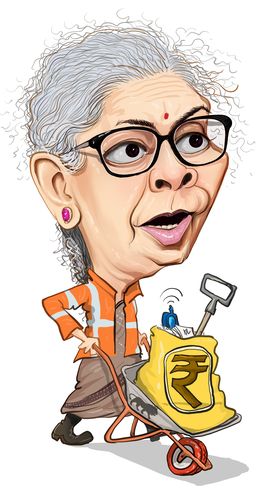What’s in a name? A currency by any other name would sound just as sweet. Sans a hefty 30 per cent to Caesar, it should.
Semantics is what Finance Minister Nirmala Sitharaman took refuge in over the confusion within the government on what to do with cryptocurrencies. Consultations are on over re-drafting the Cryptocurrency Bill, which originally sought a blanket ban. Hence, the next best thing—keep a straight face and refuse to call it ‘cryptocurrency’, even while you impose a tax on it.
“Loosely what we refer to as crypto is not currency…[only] what Reserve Bank will issue will be digital currency—anything that prevails outside is not currency [but] assets. Nothing stops me from taxing it,” Sitharaman said about her budget proposal to impose a 30 per cent tax on ‘virtual digital assets’.
Ironically, that may well be one of the clearest intentions the finance minister expressed in her fourth budget outing. Most of the rest ride high on a wing and a prayer of earnest optimism of massive government spending on highways, railways and other infra projects leading to a domino effect of increased money flow through the system generating jobs, which making people spend more, which making the private sector invest more, which leading to economic growth…. you get the drift.
As Sitharaman releases the piston on her booster shot of capital expenditure—35 per cent higher than the last year’s at nearly 011 lakh crore (when you include grants to states for investing in capital expenses)—the expectation is that the private sector will step up by loosening its purse strings, leading to wealth generation that will ‘trickle down’, spurring all-round growth and prosperity. “[This] is a speaking budget,” said Sitharaman. “The estimates are not unrealistic.”
The budget might have spoken, but the five-trillion-dollar question remains. Is India Inc listening?
“PM Modi’s vision of making India ‘atmanirbhar’ is clearly supported by a plan for the future, and backed by allocations, specifically in the areas of infrastructure, digital transition, planet resilience, education and health—to support Indian ambitions,” said N. Chandrasekaran, chairman, Tata Sons. Added Pawan Munjal, chairman & CEO, Hero MotoCorp, “The focus on infrastructure will not only improve the quality of lives and generate jobs but also help Indian industry become globally competitive.”
But, going by the industry’s track record, this remains to be seen. Most companies did more of a ‘wait and watch’ instead of sticking their necks out and investing in capacity during the slowdown days of 2019 and the pandemic, despite several rounds of stimulus and easing of credit. Sanjiv Mehta, chairman and managing director of India’s biggest consumer company, Hindustan Unilever, said as much when he called the budget “bold”. “We are all conscious that it will take some time for private consumption and private capital expenditure to pick up [but] increasing capex by 35 per cent is absolutely the right thing to do,” he said.
To Sitharaman’s credit, however, the budget refused to succumb to the temptation of populist sops in a year of crucial assembly polls. And it has steadfastly stuck to continuity, going forward with the structural reforms and advancing the ‘nudge’ theory of transformation, which is at the core of saffron economics.
The nudge theory aims at ‘nudging’ the financial system into a pro-market economy that is organised, corporatised and digital, either through regular shocks to the system (demonetisation, GST) or through dramatic fundamental changes (Atmanirbhar Bharat or farm bills).
No wonder Sitharaman said ‘digital’ 35 times and ‘tech’ 26 times in her budget speech, and the announcement of the digital rupee grabbed all the headlines. From chips in your passport and using drones for delivering fertilisers to a Make in India push for gaming and converting post offices to banks, the digit‘all’ quotient was indeed high.
“The budget announcement mainstreams India’s digital economy,” said Vikas Agnihotri, operating partner of SoftBank in India. “It points to the deepening role of tech across sectors, from agri to education to health to financial services, in making value chains efficient and resilient.”
Added Divya Gokulnath, co-founder of the learning app Byju’s, “The budget’s focus on setting up a digital university as well as e-content in all spoken languages for delivery via the internet, mobile phones, TV, radio and digital teachers confirms that edtech will play an integral role in bridging gaps in education caused by the pandemic.”
But the weak links in a seemingly exuberant ‘spend-big-and-make-it-big’ strategy are the host of glorious uncertainties that could trip up the ‘wish’ horses. Chances of oil prices crossing the $100 barrier, wholesale inflation at highs never seen after the 1990s, the still convoluted global supply chain mismatch and the fear of another wave of Covid-19 all remain high risks, especially for a budget that pins its hopes on a ‘multiplier’ strategy. The government’s confidence stems from the higher-than-expected tax revenues (GST collections hit a record of 1.4 lakh crore in January) and the faster-than-expected business recoveries witnessed. But that does not discount possible future shocks.
Considering this fragility, the reduced allocation for welfare, especially for health in the middle of a pandemic, has been surprising. Health expenditure goes down from 0.41 per cent of the GDP to 0.37 per cent next year. Money allocated for the rural job guarantee scheme NREGA continued its annual drop, falling from Rs98,000 crore to Rs73,000 crore. The outlay for food subsidies, which is at 1.23 per cent now, is estimated to fall to 0.80 per cent next year.
“Amrit Kaal (as the budget refers to the next 25 years until India hits 100 years of independence) may be digital with robust infra, but the present [is full of] distress and stagnant income,” said economist Yamini Aiyar, president and chief executive of Centre for Policy Research. “Clearly we have chosen to learn little from the ravages of Covid-19.”


